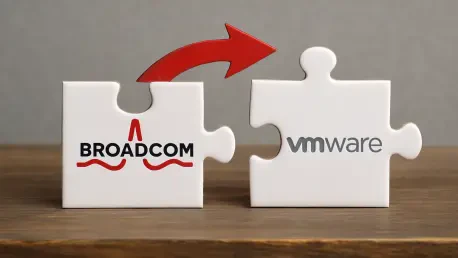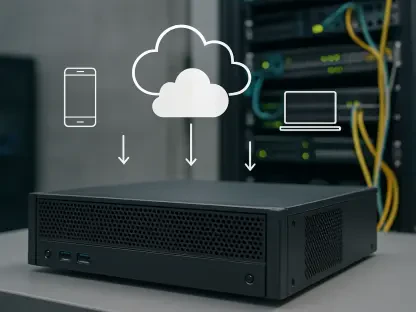In a transformative move that has sent shockwaves through the tech industry, Broadcom’s acquisition of VMware for over $60 billion in 2023 has redefined the landscape of infrastructure software, yielding extraordinary financial results while igniting a firestorm of customer discontent. This seismic shift has positioned Broadcom as a dominant player, with record-breaking revenue growth reflecting the success of a bold, enterprise-focused strategy. Yet, beneath the surface of Wall Street’s applause lies a growing unrest among VMware’s user base, frustrated by steep price increases and restrictive licensing changes. The stark contrast between soaring profits and eroding customer loyalty raises critical questions about the sustainability of such an aggressive approach. As Broadcom pushes forward with innovations like VMware Cloud Foundation (VCF), the balance between profitability and client satisfaction hangs in a delicate state. This article delves into the multifaceted impact of Broadcom’s playbook, exploring how a tech giant’s financial triumph can coexist with widespread dissatisfaction, and what this means for the future of VMware in an increasingly competitive market.
Financial Dominance in a New Era
Broadcom’s stewardship of VMware has ushered in a period of unprecedented financial success, setting new benchmarks for revenue and profitability in the infrastructure software sector. Net revenues have surged dramatically, climbing from $36 billion in 2023 to $52 billion in 2024, a clear indicator of the acquisition’s immediate impact. The third-quarter results for the current year further underscore this momentum, with revenues reaching $15.95 billion, a robust 22% increase compared to the previous year. A significant driver of this growth is the infrastructure software division, predominantly fueled by VMware, which reported earnings of $6.8 billion, up 17%. Even more striking is the operating margin for this division, which has skyrocketed to 77%, a sharp contrast to the 13-22% range seen before the acquisition. This financial leap is largely attributed to the shift toward a subscription-based licensing model, designed to maximize profitability by ensuring steady, recurring income from clients. For investors and analysts, these figures paint a picture of a company executing a highly effective strategy, capitalizing on VMware’s established market presence to deliver exceptional returns.
Beyond the headline numbers, the financial strategy reveals a deliberate focus on high-margin opportunities that prioritize long-term stability over short-term gains. The subscription model, while controversial among users, has provided Broadcom with a predictable revenue stream, insulating it from the volatility often seen in traditional software sales. This approach has also enabled significant reinvestment into core areas, enhancing the company’s ability to scale operations and drive further growth. Analysts have noted that the improved margins reflect not just cost-cutting measures, but a fundamental restructuring of how VMware’s offerings are monetized. By aligning pricing with perceived value for larger clients, Broadcom has managed to extract greater profitability from its customer base, even as it navigates the complexities of a diverse market. However, this financial prowess comes with trade-offs, as the very mechanisms driving these gains are at the heart of customer grievances, setting the stage for a broader debate about the ethics and efficacy of such a profit-driven transformation.
Enterprise Focus and Strategic Overhaul
At the core of Broadcom’s post-acquisition strategy lies a calculated pivot toward the largest enterprise customers, reshaping VMware’s business model to cater almost exclusively to the top 10,000 clients. This elite segment has been encouraged, and in many cases compelled, to adopt VMware Cloud Foundation (VCF), a comprehensive private cloud platform bundling multiple services into a single offering. Reports indicate that over 90% of these major clients have transitioned to VCF, often locking into multi-year renewal contracts that ensure sustained revenue for Broadcom. This laser focus on big players is not accidental; it reflects a deliberate choice to maximize value from organizations with the resources to absorb higher costs and the infrastructure to leverage complex solutions. CEO Hock Tan has publicly emphasized the significant benefits these large clients derive from VCF, positioning it as a cornerstone of modern enterprise IT environments. Yet, this strategy inherently prioritizes a narrow slice of the market, creating a ripple effect that reverberates through the broader customer ecosystem.
The flip side of this enterprise-centric approach is the marginalization of smaller and mid-sized businesses, which constitute a substantial portion of VMware’s historical user base. These companies, numbering in the tens of thousands, face pricing structures and licensing terms that often feel punitive, lacking the tailored value propositions offered to larger counterparts. Many in this segment report struggling to justify the costs associated with VCF, especially when their usage is limited to basic functionalities rather than the full spectrum of bundled features. Public statements from Broadcom’s leadership acknowledge this disparity, admitting that the benefits of their flagship platform are less evident to the next tier of 20,000 to 30,000 customers. This segmentation has fostered a sense of exclusion among smaller firms, who feel sidelined by a company once known for its wide accessibility. As a result, the strategic overhaul, while financially lucrative, risks fracturing VMware’s once-unified community, pushing many to question their long-term allegiance to the brand.
Rising Costs and Customer Backlash
A pervasive wave of frustration has engulfed VMware’s customer base, driven by dramatic price increases that have reshaped the cost dynamics of using the company’s solutions. Reports highlight hikes ranging from 50% to 400%, with some high-profile cases, such as AT&T, experiencing surges as extreme as 1,050%. These escalating costs have not gone unnoticed, triggering a backlash that manifests in both vocal discontent and formal legal challenges. Major organizations, including Siemens and Tesco, alongside entities like the Dutch Ministry of Infrastructure and Water Management, have initiated lawsuits, accusing Broadcom of predatory pricing and restrictive practices. The financial burden, coupled with a perceived lack of proportional value, has eroded trust among users who once viewed VMware as a reliable partner. This unrest is not merely anecdotal; it reflects a systemic issue that threatens to undermine the goodwill built over decades, as clients grapple with budgets stretched thin by unexpected expenses.
Further compounding the dissatisfaction is the sentiment captured in industry surveys, which paint a grim picture of customer sentiment toward Broadcom’s policies. A study by Rimini Street involving 111 global VMware users revealed that an overwhelming 98% are either considering or actively pursuing alternative solutions. The primary drivers of this shift include prohibitive costs, cited by 45% of respondents, alongside fears of future price hikes, noted by 43%. Additional grievances center on declining support quality and frustration with the mandatory shift to subscription-based licensing, highlighting a disconnect between Broadcom’s strategic goals and customer expectations. This widespread discontent signals a potential mass exodus, as businesses of all sizes reevaluate their reliance on VMware’s ecosystem. The legal and public relations challenges mounting against Broadcom suggest that addressing these concerns is no longer optional but imperative to maintaining a viable market position amidst growing scrutiny.
Competitive Threats and Market Erosion
As customer dissatisfaction with VMware intensifies, the competitive landscape is undergoing a profound transformation, with analysts forecasting a significant decline in the company’s market share over the coming years. Current estimates suggest a drop from 70% in 2024 to just 40% by 2029, a stark indicator of the challenges Broadcom faces in retaining its dominance. Competitors are swiftly capitalizing on this unrest, offering viable alternatives that appeal to frustrated users. Platforms such as Microsoft Hyper-V, with 69% of surveyed customers considering a switch, alongside Oracle VirtualBox and Red Hat Virtualization, are gaining ground as credible substitutes. Additionally, open-source options like Proxmox and KVM are attracting attention for their cost-effectiveness and flexibility, providing a refuge for businesses seeking to escape Broadcom’s pricing model. This shift reflects a broader market fragmentation, where choice is becoming a powerful weapon against VMware’s once-unassailable position.
Among the standout beneficiaries of this trend is Nutanix, which has reported adding over 2,700 new customers in the past year, including more than 50 accounts from the Global 2000 list. This growth underscores the appeal of alternative providers who prioritize affordability and customer-centric solutions over bundled, high-cost packages. Hyperscalers like AWS and Azure are also making significant inroads, offering migration tools specifically designed to ease the transition away from VMware environments. These cloud giants present scalable, cost-effective options that resonate with companies looking to modernize their infrastructure without the burden of escalating fees. The proliferation of such alternatives, supported by active marketing and technical assistance for switching, poses a direct threat to Broadcom’s hold on the market. As more businesses explore these options, the erosion of VMware’s share becomes not just a prediction, but an unfolding reality that demands strategic recalibration.
Innovation Challenges and Technological Ambitions
Broadcom’s vision for VMware centers on positioning VMware Cloud Foundation (VCF) as a pioneering, AI-native private cloud platform, tailored for on-premises infrastructure in an era increasingly dominated by public cloud solutions. Recent unveilings at industry events have spotlighted enhancements such as AI-driven security features and strategic partnerships aimed at bolstering container-based and AI applications. These advancements are pitched as transformative, offering enterprises a robust alternative to cloud migration by emphasizing performance and data sovereignty. The company’s leadership has framed VCF as the future of enterprise IT, a comprehensive solution designed to meet the complex demands of modern workloads while maintaining control over sensitive data. This technological push reflects an ambition to redefine VMware’s role in the industry, moving beyond traditional virtualization to a broader, more integrated platform that addresses emerging needs in security and automation.
However, the reception to these innovations reveals a significant gap between Broadcom’s aspirations and customer realities, as adoption of VCF’s full capabilities remains inconsistent across the user base. Many clients, particularly those outside the top enterprise tier, report utilizing only the basic virtualization features of the platform, rendering the bundled package disproportionately expensive relative to their needs. This mismatch fuels skepticism about the practical value of VCF, with critics arguing that the cost often outweighs the benefits for businesses not fully leveraging its advanced functionalities. Feedback from recent industry gatherings suggests a lukewarm response, with limited enthusiasm for Broadcom’s broader vision despite the technical merits of the updates. This disconnect highlights a critical challenge: while the technology may be cutting-edge, its relevance and accessibility to a diverse customer pool are not guaranteed, risking further alienation if pricing and utility are not aligned more closely with user expectations.
Partner Dynamics and Operational Streamlining
Broadcom’s strategic overhaul extends beyond customer segmentation and pricing to encompass a significant restructuring of its partner and vendor ecosystem, resulting in a leaner but more focused operational model. By trimming down the network of collaborators, the company has prioritized relationships with key players who align with its enterprise-centric vision, aiming to enhance efficiency and streamline service delivery. This shift, while disruptive in the short term, is seen by some industry observers as a necessary step toward greater innovation and value creation for top-tier clients. The reduction in partnerships is intended to eliminate redundancies and sharpen focus on delivering tailored solutions through VMware Cloud Foundation (VCF), ensuring that resources are allocated where they can generate the most impact. However, this move has not been without friction, as many long-standing partners find themselves excluded from Broadcom’s narrowed scope, leading to tensions within the channel community.
The impact of this streamlined approach was evident at recent industry events, where a noticeable decline in vendor presence and overall attendance signaled a departure from VMware’s traditionally broad engagement model. The focus on a smaller, more targeted group of enterprise clients and partners reflects Broadcom’s intent to double down on high-value relationships rather than maintaining a wide-reaching network. While some analysts argue that this positions the company for more agile innovation and better service quality for its core clientele, others caution that it risks alienating a significant portion of the ecosystem that once contributed to VMware’s market strength. The long-term implications of this channel shake-up remain uncertain, as Broadcom must balance the benefits of a tighter operational focus with the potential loss of diversity and reach in its partner landscape, a dynamic that could influence its ability to adapt to evolving market demands.
Navigating the Future Amidst Tension
Reflecting on Broadcom’s journey with VMware, the past few years have revealed a stark duality of outcomes that shaped the trajectory of a once-universally trusted tech stalwart. The financial achievements stand out as a testament to strategic precision, with revenue milestones and margin improvements that captivated investors and analysts alike. Infrastructure software earnings swelled, driven by a subscription model that transformed profitability, while the company’s focus on elite enterprise clients secured a steady income stream through multi-year commitments. Yet, this success was mirrored by a profound customer backlash, as price surges and rigid policies pushed many toward legal action and alternative providers. The projected decline in market share serves as a sobering reminder of the fragility of dominance when user trust erodes.
Looking ahead, the path for Broadcom involves a critical reassessment of how to sustain financial momentum without sacrificing customer goodwill. Addressing the grievances of smaller and mid-sized businesses through flexible pricing or modular offerings could stem the tide of defections to competitors like Nutanix and hyperscalers. Enhancing the perceived value of VCF by aligning costs with actual usage patterns might bridge the adoption gap, ensuring that innovation translates into practical benefits for a broader audience. Furthermore, rebuilding trust through improved support and transparent communication stands as a vital step to mitigate legal and reputational risks. As the competitive landscape continues to evolve, Broadcom must adapt by fostering a more inclusive strategy that balances enterprise priorities with the needs of its diverse user base, ensuring that VMware’s legacy as a market leader endures amidst these turbulent shifts.









